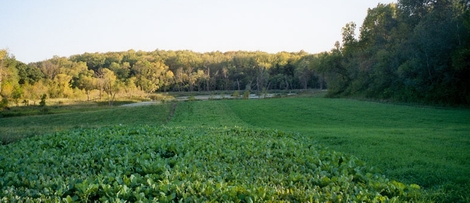
Unless you are a wheat farmer, every landowner or hunter wants to see more wild turkey on their property. The best way to ensure that turkeys flourish on your property is to create high-quality habitat that provides adequate food and cover requirements. A great way to attract and hold turkeys on your land is to clear and maintain wildlife food plots. Creating and retaining forest openings should be an important component of any turkey management program. If your property is comprised of dense woodlands, then first you must create openings within the forested area for plots to be planted.
Forest openings will allow your turkey food plot to receive adequate amounts of sunlight, thrive, and provide supplemental food for your turkey population. Food plots are a good idea because they attract deer and turkey, but more importantly these plots provide supplemental food for game and other species of wildlife. Establishing and maintaining turkey plots can be expensive and, of course, requires some knowledge of planting and the skill in the proper use of farm equipment. Before jumping into a food plot, make sure you take the time to identify the forage species that is best suited for your area.
This is necessary to ensure that your food plot yields the highest results possible. Even with that said, one of the most often overlooked factors of food plots is soil testing and proper seedbed preparation. In addition, make sure that planting depth and nutrient requirements are met. The size of the seed to be planted and soil moisture conditions are two primary considerations before planting your turkey plot. Seedbeds for small-seeded plants such as clovers need to be as smooth and clean as possible. On the other hand, large-seed plants like corn, peas, and beans do not require as neat a seedbed. These robust seeds can literally plow right through the soil and around clods to get sunlight.
I guess now would be a good time to give you some food plot planting tips. First, soil that is too wet will create a hard and rough seedbed because of soil particles sticking together. On the other hand, when soil moisture low, working a seedbed will release the moisture needed to germinate seeds. In addition, make sure that the seedbed is not overly loose. Seed-to-soil contact is very important and very loose seedbeds loose moisture rapdily. This will not allow your food plot seeds to quickly germinate and grow.
Prior to planting any type of turkey forage seed, make sure that you test the soil to determine the amount of lime and fertilizer needed, if any. Often times, soils are not exactly ready for the seeds you want to plant. In this case, an inexpensive soil test can tell you if your soil has got what it takes or if you need to do a little tweaking before spending time and money on an unsuccessful food plot. A soil test will identify the unknowns and make efficient use of your time. And just so you know, most forest soils are acidic and low in nutrients, so be prepared to add lime and fertilizer before your seeds go into the ground. When adding lime, make sure that you do so well in advance of planting. Lime takes a substantial amount of time to react with the soil and adjust pH. Fertilizer, on the other hand, can be applied either before or after the seedbed has been prepared.
In short, nothing beats turkey food plots for providing supplemental forage for your turkey population. These single or multi-species plots can be targeted directly at wild turkey or towards other game species as well, such as white-tailed deer. Food plots may take some preparation and work, but nothing worth having comes easy. Supplemental food as planted plots will benefit many species of wildlife and improve your turkey and whitetail hunting. Good luck with your food plot and turkey management program!